Nonstationary Ecological Instream Flow and Relevant Causes in the Huai River Basin, China
Abstract
:1. Introduction
2. Study Area and Data
3. Methods
3.1. Eco-Surplus and Eco-Deficit
3.2. Hydrological Alterations
3.3. Indicators for Evaluation of Ecological Diversity
3.4. GAMLSS Model
4. Results
4.1. Changes in the Ecological Instream Flow
4.2. Impacts of Ecological Instream Flow Changes on Biodiversity
4.3. Comparison Between Ecologically-Relevant Hydrological Indicators and IHA33
4.4. Potential Impacts of Climate Factors on Ecological Instream Flow
5. Discussion
6. Conclusions
- (1)
- Using Pettitt non-parametric test method to detect the daily runoff change point time, the trend has a Significantly hydrological alterations in the HRB. The eco-surplus has a decreased trend when compared to those before hydrological alteration occurred and the eco-deficit was also found to decrease after the change point, and the eco-deficit in the mainstream has a significantly increasing trend than that in the tributary. Meanwhile, regional precipitation is the primary factor for the variation of eco-surplus and eco-deficit on the annual scale. Moreover, eco-surplus and eco-deficit are significantly correlated with precipitation in spring, autumn and winter. However, summer precipitation anomalies are not inconsistent with the variations of ecological instream flow indices in the Jiangjiaji and Fuyang stations, which resulted from the reservoir regulation and vegetation interception.
- (2)
- The most noticeable change in the Shannon Index calculated by IHA was the decrease, indicating that the biodiversity of the HRB was decreasing. Besides, the Shannon index was significantly positively correlated with the eco-surplus except Fuyang station (r > 0.31, p < 0.01) and negatively correlated with eco-deficit (r > 0.31, p < 0.01). There is a good correlation between IHA32 hydrological indicators and ecological instream flow indices, such as eco-surplus and eco-deficit, showing that eco-surplus and eco-deficit can be regarded as suitable ecological instream flow indicators to illustrate seasonal and annual ecological flow change.
- (3)
- Exponential Gaussian distribution is the appropriate distribution function with the lowest of AIC in the study of ecological instream flow in the Wangjiaba, Lutaizi, Bengbu stations of the mainstream, followed by the t Family distribution in the tributary of HRB. Meanwhile, Ecological instream flow is primarily affected by PDO, NAO and Nino3.4, and the GAMLSS model 8, considering climate factors, was regarded as appropriate distribution in hydrological variation analysis. Moreover, the ecological instream flow by GAMLSS model has better performance in the fitting of local trend and extreme value. The changes of ecological instream flow have been significantly impacted by the land-use type change. Moreover, agricultural and industrial water use are the mainly cause ecological instream flow decline.
Author Contributions
Funding
Institutional Review Board Statement
Informed Consent Statement
Data Availability Statement
Conflicts of Interest
References
- Zhang, Q.; Gu, X.H.; Singh, V.P.; Chen, X.H. Evaluation of ecological instream flow using multiple ecological indicators with consideration of hydrological alterations. J. Hydrol. 2015, 529, 711–722. [Google Scholar] [CrossRef]
- Tharme, R.E. A global perspective on environmental flow assessment: Emerging trends in the development and application of environmental flow methodologies for rivers. River Res. Appl. 2003, 19, 397–441. [Google Scholar] [CrossRef]
- Zhang, Q.; Zhang, Z.J.; Shi, P.J.; Singh, V.P.; Gu, X.H. Evaluation of ecological instream flow considering hydrological alterations in the Yellow River basin, China. Glob. Planet. Chang. 2018, 160, 61–74. [Google Scholar] [CrossRef]
- Gao, B.; Yang, D.W.; Zhao, T.T.G.; Yang, H.B. Changes in the eco-flow metrics of the Upper Yangtze River from 1961 to 2008. J. Hydrol. 2012, 448, 30–38. [Google Scholar] [CrossRef]
- Poff, N.L.; Allan, J.D.; Bain, M.B.; Karr, J.R.; Prestegaard, K.L.; Richter, B.D.; Sparks, R.E.; Stromberg, J.C. The natural flow regime: A paradigm for river conservation and restoration. Bioscience 1997, 47, 769–784. [Google Scholar] [CrossRef]
- Hart, D.D.; Finelli, C.M. Physical–biological coupling in streams: The pervasive effects of flow on benthic organisms. Annu. Rev. Ecol. Syst. 1999, 30, 363–395. [Google Scholar] [CrossRef]
- Seneviratne, S.I.; Nicholls, N.; Easterling, D.; Goodess, C.M.; Kanae, S.; Kossin, J.; Luo, Y.; Marengo, J.; McInnes, K.; Rahimi, M.; et al. Changes in Climate Extremes and Their Impacts on the Natural Physical Environment. In Managing the Risks of Extreme Events and Disasters to Advance Climate Change Adaptation; A Special Report of Working Groups I and II of the Intergovernmental Panel on Climate Change (IPCC); Cambridge University Press: Cambridge, UK; New York, NY, USA, 2012; pp. 109–230. [Google Scholar]
- Wang, Y.; Zhao, W.; Wang, S.; Feng, X.M.; Liu, Y.X. Yellow River water rebalanced by human regulation. Sci. Rep. 2019, 9, 9707. [Google Scholar] [CrossRef] [PubMed] [Green Version]
- Park, K.; Lee, K.S.; Kim, Y.-O. Use of Instream Structure Technique for Aquatic Habitat Formation in Ecological Stream Restoration. Sustainability 2018, 10, 4032. [Google Scholar] [CrossRef] [Green Version]
- Wang, X.Q.; Liu, C.M.; Yang, Z.F. Method of resolving lowest environmental water demands in river course (I)—Theory. Acta Sci. Circumstantiae 2001, 21, 544–547. [Google Scholar]
- Xing, Z.; Wang, Y.; Gong, X.; Wu, J.; Ji, Y.; Fu, Q. Calculation of Comprehensive Ecological Flow with Weighted Multiple Methods Considering Hydrological Alteration. Water 2018, 10, 1212. [Google Scholar] [CrossRef] [Green Version]
- Cui, Y.; Zhang, Q.; Chen, X.H.; Jiang, T. Advances in the theories and calculation methods of ecological water requirement. J. Lake Sci. 2010, 22, 465–480. [Google Scholar]
- Geoffrey, E.P. Instream flow science for sustainable river management. J. Am. Water Resour. Assoc. 2009, 45, 1071–1086. [Google Scholar]
- Zhang, C.; Wan, Z.; Jing, Z.; Zhang, S.; Zhao, Y. Calculation of ecological water requirements of urban rivers using a hydrological model: A case study of Beiyun River. J. Clean Prod. 2020, 262, 121368. [Google Scholar] [CrossRef]
- Danial, C.; Nassir, E.J. Comparison and regionalization of hydrologically based instream flow. Can. J. Civ. Eng. 1995, 5, 235–246. [Google Scholar]
- Barrett, M.P.J. An Evaluation of the Instream Flow Incremental Methodology (IFIM). J. Clean Prod. 1992, 24, 75–77. [Google Scholar]
- Yu, L.J.; Xia, Z.Q.; Du, X.S. Connotation of minimum ecological runoff and its calculation method. J. Hehai Univ. 2004, 32, 18–22. [Google Scholar]
- Lee, S.; Kim, J.; Hur, J.W. Assessment of ecological flow rate by flow duration and environmental management class in the Geum River, Korea. Environ. Earth Sci. 2012, 68, 1107–1118. [Google Scholar] [CrossRef]
- Richter, B.; Baumgartner, J.; Wigington, R.; BRAUN, D. How much water does a river need? Freshw. Biol. 1997, 37, 231–249. [Google Scholar] [CrossRef] [Green Version]
- Richter, B.D.; Baumgartner, J.V.; Powell, J.; Braun, D.P. A method for assessing hydrologic alteration within ecosystems. Conserv. Biol. 1996, 10, 1163–1174. [Google Scholar] [CrossRef] [Green Version]
- Ehsani, N.; Fekete, B.M.; Vörösmarty, C.J.; Tessler, J.D. A neural network based general reservoir operation scheme. Stoch. Environ. Res. Risk Assess. 2016, 30, 1151–1166. [Google Scholar] [CrossRef] [Green Version]
- Chen, Y.D.; Yang, T.; Xu, C.-Y.; Zhang, Q.; Chen, X.; Hao, Z. Hydrologic alteration along the Middle and Upper East River (Dongjiang) basin, South China: A visually enhanced mining on the results of RVA method. Stoch. Environ. Res. Risk Assess. 2010, 24, 9–18. [Google Scholar] [CrossRef]
- Zhang, Q.; Xiao, M.; Liu, C.-L.; Singh, V.P. Reservoir-induced hydrological alterations and environmental flow variation in the East River, the Pearl River basin, China. Stoch. Environ. Res. Risk Assess. 2014, 28, 2119–2132. [Google Scholar] [CrossRef]
- The Huai River Commission of the Ministry of Water Resources, P.R.C. Introduction: Huai River Basin. 2008. Available online: http://www.hrc.gov.cn/lyjs.jhtml (accessed on 11 March 2018).
- Sun, P.; Zhang, Q.; Wen, Q.Z.; Singh, V.P.; Shi, P.J. Multisource data based integrated agricultural drought monitoring in the Huai River basin, China. J. Geophys. Res. 2017, 122, 10751–10772. [Google Scholar] [CrossRef]
- Sun, P.; Sun, Y.Y.; Zhang, Q.; Wen, Q.Z. Temporal and spatial variation characteristics of runoff processes and its causes in Huaihe Basin. J. Lake Sci. 2018, 30, 497–508. [Google Scholar]
- Sun, P.; Sun, Y.Y.; Zhang, Q.; Yao, R. Hydrological processes in the Huaihe River Basin, China: Seasonal variations, causes and implications. Chin. Geogr. Sci. 2018, 28, 636–653. [Google Scholar] [CrossRef] [Green Version]
- Sun, P.; Wen, Q.Z.; Zhang, Q.; Singh, V.P.; Sun, Y.Y.; Li, J.F. Nonstationarity-based evaluation of flood frequency and flood risk in the Huai River basin, China. J. Hydrol. 2018, 567, 393–404. [Google Scholar] [CrossRef]
- Sun, P.; Zhang, Q.; Yao, R.; Singh, V.P.; Song, C.Q.; Sun, Y.Y. Spatiotemporal Patterns of Extreme Temperature across the Huai River Basin, China, during 1961–2014, and Regional Responses to Global Changes. Sustainability 2018, 10, 1236. [Google Scholar] [CrossRef] [Green Version]
- Liu, C.M.; Zhao, C.S.; Xia, J.; Sun, C.l.; Wang, R.; Liu, T. An instream ecological flow method for data-scarce regulated rivers. J. Hydrol. 2011, 398, 17–25. [Google Scholar] [CrossRef]
- Liu, S.X.; Mo, X.G.; Xia, J.; Liu, C.M.; Lin, Z.H.; Men, B.H.; Ji, L. Estimating the minimum in-stream flow requirements via wetted perimeter method based on curvature and slope techniques. J. Geogr. Sci. 2006, 16, 242–250. [Google Scholar] [CrossRef]
- Pan, Z.R.; Ruan, X.H. Spatio-temporal analysis of satisfactory degree of ecological water demand in Huaihe River Basin. J. Hydraul. Eng. ASCE 2015, 46, 280–290. [Google Scholar]
- Liu, D.; Xing, Q.Q.; Guo, X.X.; Ma, M.M.; Fan, P.Y. Ecological hydraulic radius approach and its applications in ecological water demand calculation in the Jialu River Basin. J. Water Resour. Water Eng. 2018, 29, 105–110. [Google Scholar]
- Zuo, Q.; Chen, H.; Zhang, Y. Impact factors and health assessment of aquatic ecosystem in Upper and Middle Huai River Basin. J. Hydraul. Eng. ASCE 2015, 46, 1019–1027. [Google Scholar]
- Milly, P.C.D.; Betancourt, J.; Falkenmark, M.; Hirsch, R.M.; Kundzewicz, Z.W.; Lettenmaier, D.P.; Stouffer, R.J. Stationarity is dead: Whiter water management? Science 2018, 319, 573–574. [Google Scholar] [CrossRef] [PubMed]
- Berg, P.; Moseley, C.; Haerter, J.O. Strong increase in convective precipitation in response to higher temperatures. Nat. Geosci. 2013, 6, 181–185. [Google Scholar] [CrossRef]
- Bolgov, M.V.; Sentsova, N.I. Bayesian assessments of design characteristics of the minimum river runoff under nonstationary conditions. Russ. Meteorol. Hydrol. 2010, 35, 769–776. [Google Scholar] [CrossRef]
- Kunkel, K.E.; Karl, R.T.; Easterling, R.D.; Redmond, K.; Young, J.; Yin, X.; Hennon, P. Probable maximum precipitation and climate change. Geophys. Res. Lett. 2013, 40, 1402–1408. [Google Scholar] [CrossRef]
- Zhang, Q.; Gu, X.H.; Singh, V.P.; Xiao, M.; Xu, C.-Y.; Chen, X. Evaluation of flood frequency under non-stationarity resulting from climate change and human activities in the East River basin, China. J. Hydrol. 2015, 527, 565–575. [Google Scholar] [CrossRef]
- Gilroy, K.L.; McCuen, R.H. A nonstationary flood frequency analysis method to adjust for future climate change and urbanization. J. Hydrol. 2012, 414, 40–48. [Google Scholar] [CrossRef]
- Prosdocimi, I.; Kjeldsen, T.R.; Miller, J.D. Detection and attribution of urbanization effect on flood extremes using nonstationary flood-frequency models. Water Resour. Res. 2015, 51, 4244–4262. [Google Scholar] [CrossRef] [PubMed] [Green Version]
- Chang, J.X.; Li, Y.Y.; Wang, Y.M.; Yuan, M. Copula-based drought risk assessment combined with an integrated index in the Wei River Basin. China J. Hydrol. 2016, 540, 824–834. [Google Scholar] [CrossRef]
- Zhang, Y.Y.; Shao, Q.X.; Xia, J.; Stuart, E.B.; Zuo, Q.T. Changes of flow regimes and precipitation in Huai River Basin in the last half century. Hydrol. Process. 2011, 25, 246–257. [Google Scholar] [CrossRef] [Green Version]
- Sun, P.; Zhang, Q.; Yao, R.; Wen, Q.Z. Hydrological Drought Regimes of the Huai River Basin, China: Probabilistic Behavior, Causes and Implications. Water 2019, 11, 2390. [Google Scholar] [CrossRef] [Green Version]
- Pettitt, A.N. A non-parametric approach to the change-point problem. J. R. Stat. Soc. 1979, 28, 126–135. [Google Scholar] [CrossRef]
- Vogel, M.R.; Sieber, J.; Archfield1, A.S.; Smith, P.M.; Apse, D.C.; Huber-Lee, A. Relations among storage, yield, and instream flow. Water Resour. Res. 2007, 43, W05403. [Google Scholar] [CrossRef]
- The Nature Conservancy, Indicators of Hydrological Alteration Version 7.1 User’s Manual: 2009. Available online: http://www.conservationgateway.org/ConservationPractices/Freshwater/EnvironmentalFlows/MethodsandTools/IndicatorsofHydrologicAlteration/Pages/IHA-Software-Download.aspx (accessed on 22 September 2020).
- Shiau, J.T.; Wu, F.C. Pareto-optimal solutions for environmental flow schemes incorporating the intra-annual and interannual variability of the natural flow regime. Water Resour. Res. 2007, 43, W06433. [Google Scholar] [CrossRef]
- Kuo, S.R.; Lin, J.H.; Shao, K.T. Seasonal changes in abundance and composition of the fish assemblage in Chiku Lagoon, south-western Taiwan. Bull. Mar. Sci. 2001, 68, 85–99. [Google Scholar]
- Yang, Y.-C.E.; Cai, X.M.; Herricks, E.E. Identification of hydrologic indicators related to fish diversity and abundance. A data mining approach for fish community analysis. Water Resour. Res. 2008, 44, W04412. [Google Scholar] [CrossRef]
- Rigby, R.A.; Stasinopoulos, D.M. Generalized additive models for location, scale and shape. J. R. Stat. Soc. 2005, 54, 507–555. [Google Scholar] [CrossRef] [Green Version]
- Wang, Y.X.; Zuo, Q.T. Analysis of water quality change and its reasons in Henan Reach of Shayinghe River. J. Water Resour. Water Eng. 2012, 23, 47–50. [Google Scholar]
- Zuo, Q.T.; Liu, Z.H.; Dou, M.; Gao, J.S. Research Framework of Assessment of Dams' Impact on Water Quality and Quantity and Identification of Regulation Ability. South North Water Transf. Water Sci. Technol. 2011, 9, 18–21. [Google Scholar]
- Chen, H.; Zuo, Q.T.; Zhang, Y.Y. Impact factor analysis of aquatic species diversity in the Huai River Basin, China. Water Sci. Technol. Water Supply 2019, 19, 2061–2071. [Google Scholar] [CrossRef]
- Aho, K.; Derryberry, D.; Peterson, T. Model selection for ecologists: The worldviews of AIC and BIC. Ecology 2014, 95, 631–636. [Google Scholar] [CrossRef] [PubMed]
- Li, M.; Liang, X.; Xiao, C.; Zhang, X.; Jang, W. Evaluation of Reservoir-Induced Hydrological Alterations and Ecological Flow Based on Multi-Indicators. Water 2020, 12, 2069. [Google Scholar] [CrossRef]
- Harnessing the Huaihe River Proceedings Codification Committee. Harnessing the Huaihe River Proceedings; Harnessing the Huaihe River Proceedings Editorial Department: Bengbu, China, 2017. [Google Scholar]
- Sun, Y.Y.; Sun, P.; Yao, R.; Zhang, Q.; Shi, P.J.; Wang, Y.Z. Characteristics of low streamflow: Possible causes and implications in Huaihe River basin. J. Beijing Norm. Univ. 2018, 54, 543–552. [Google Scholar]
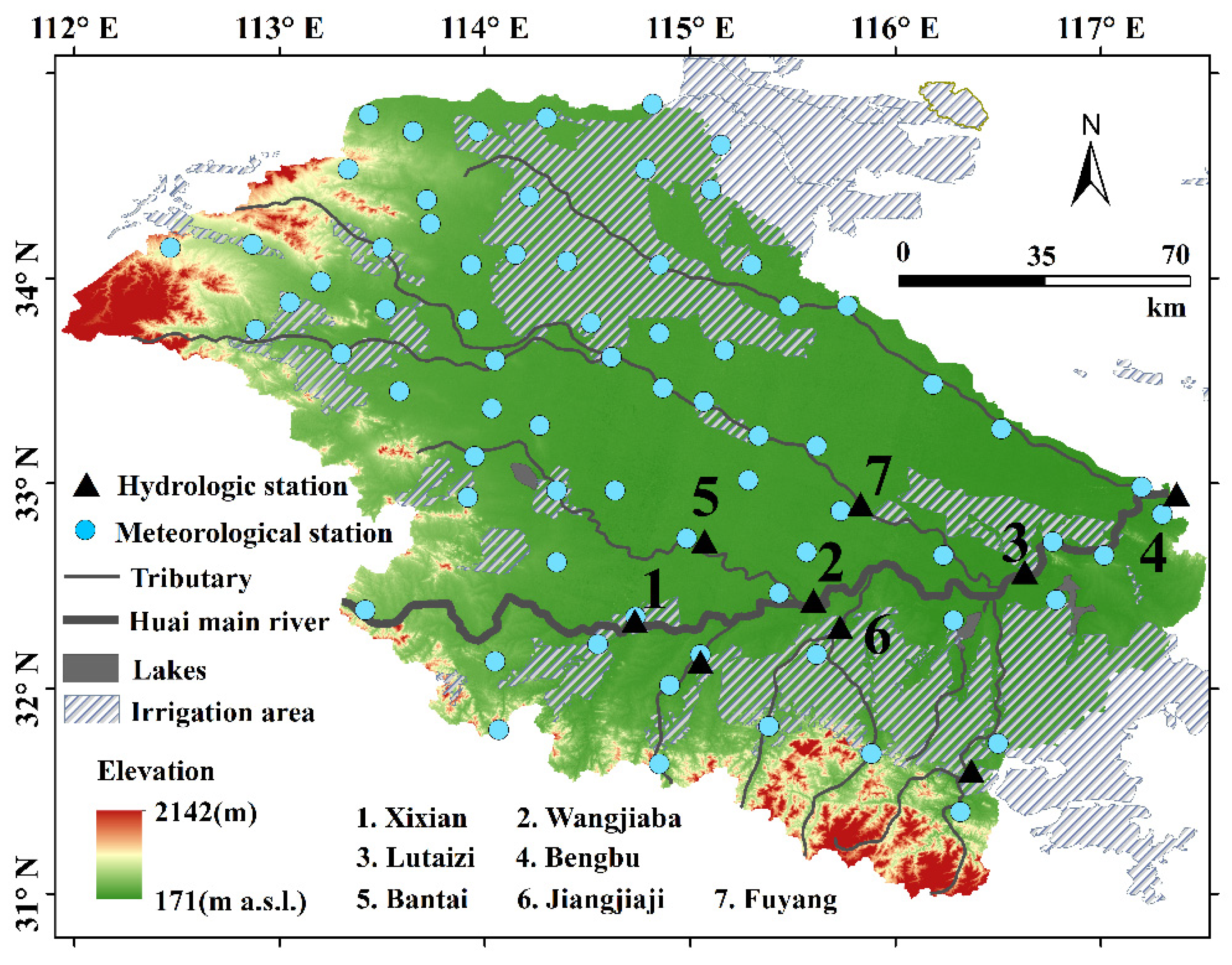
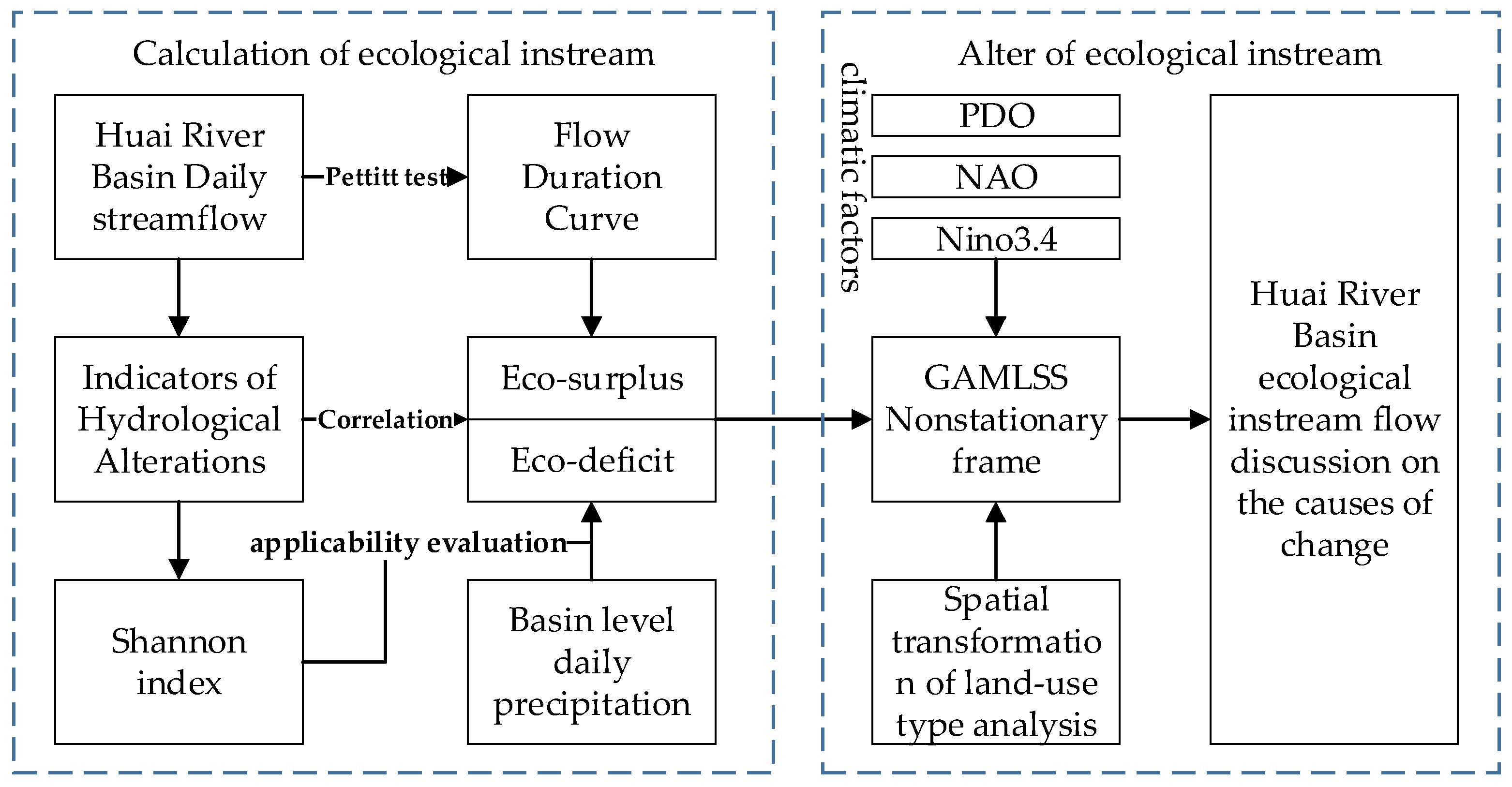
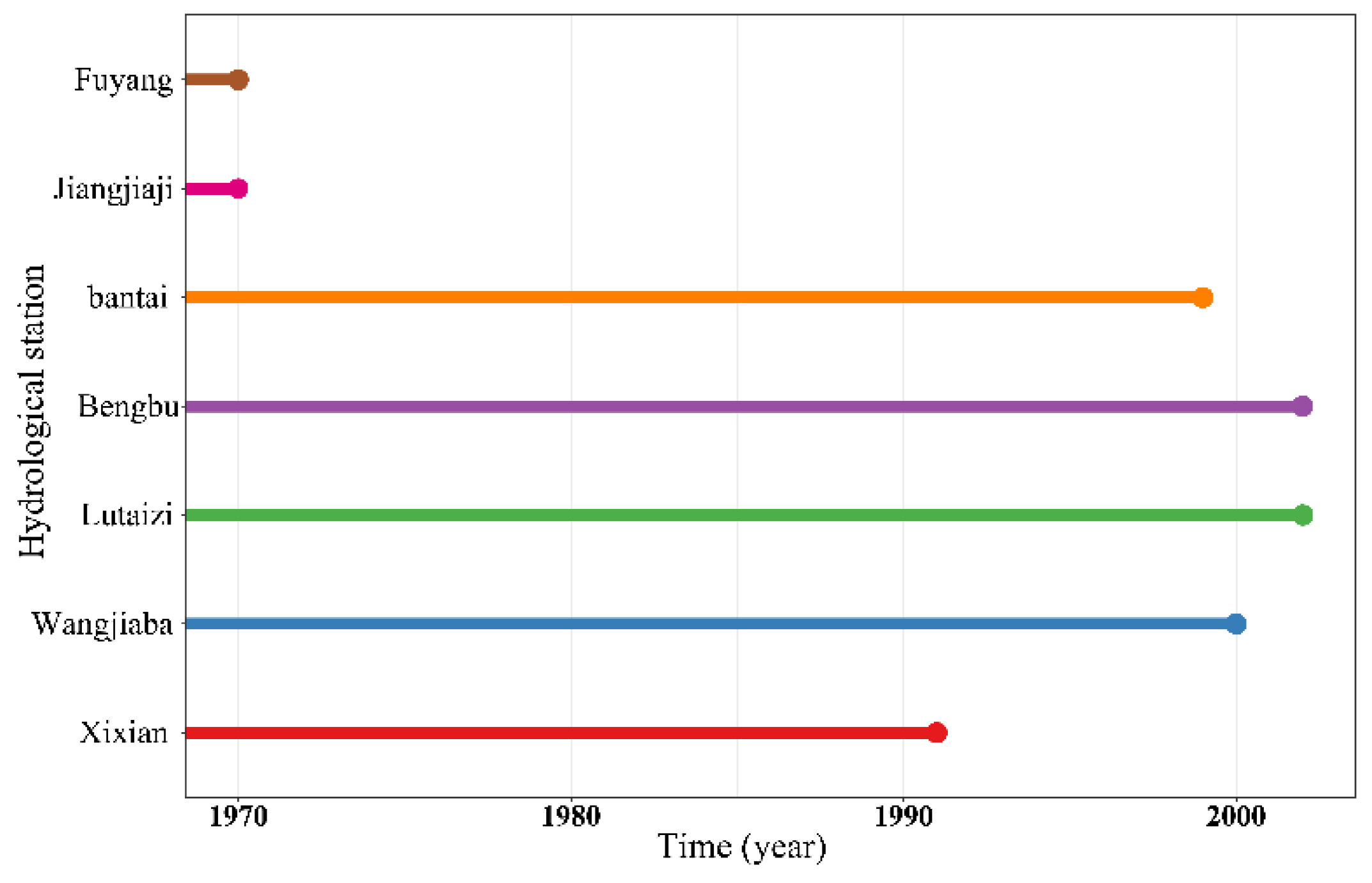
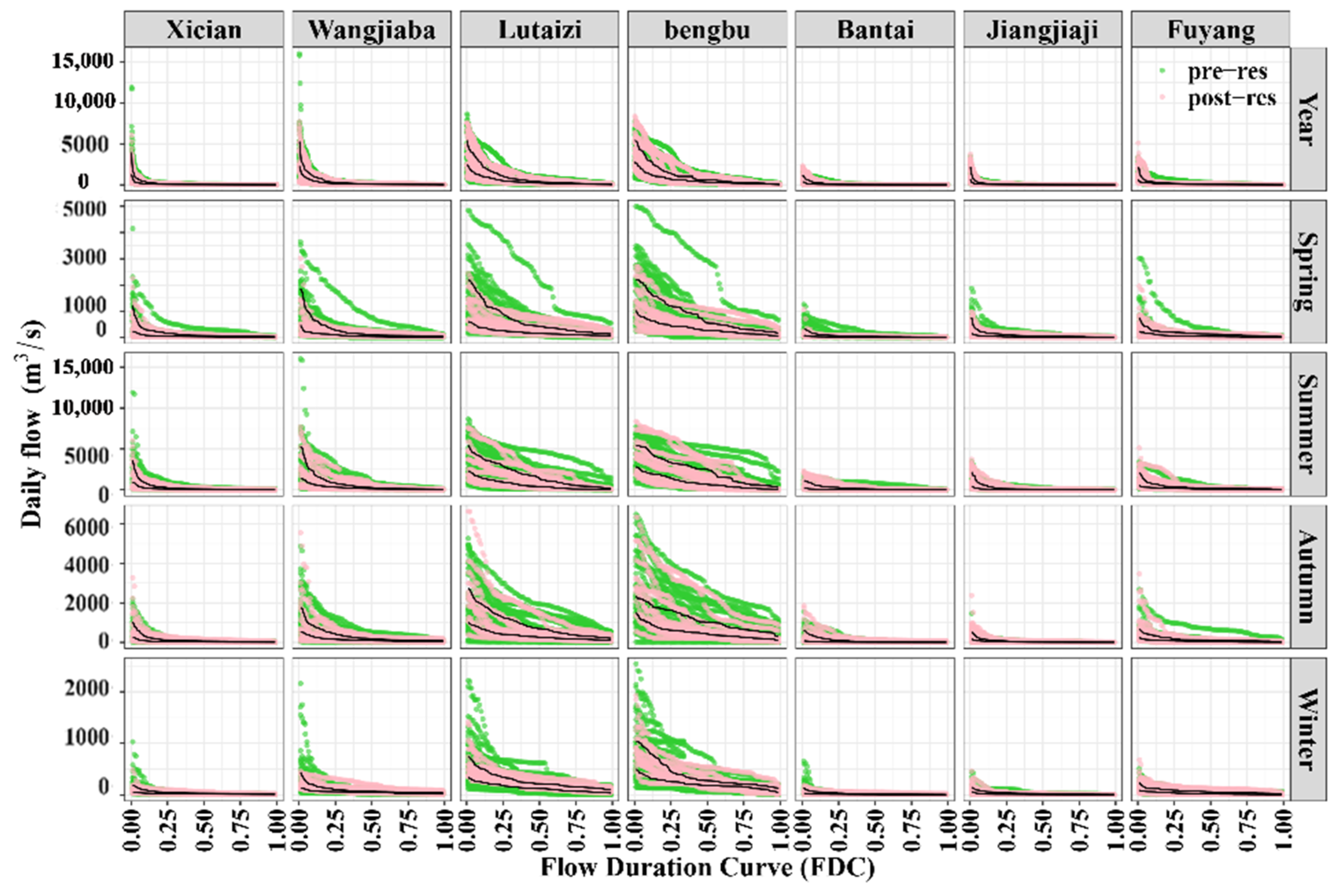
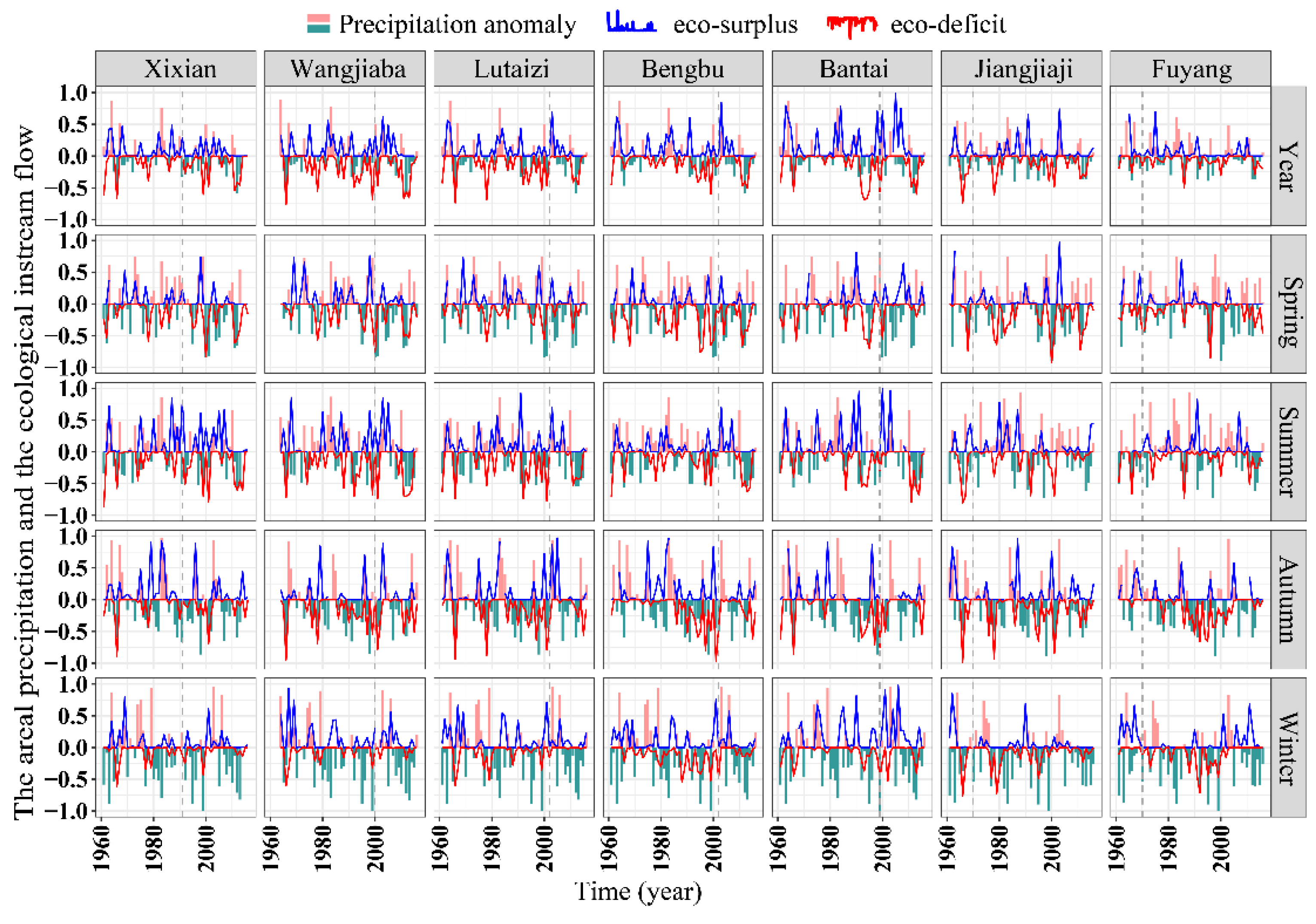
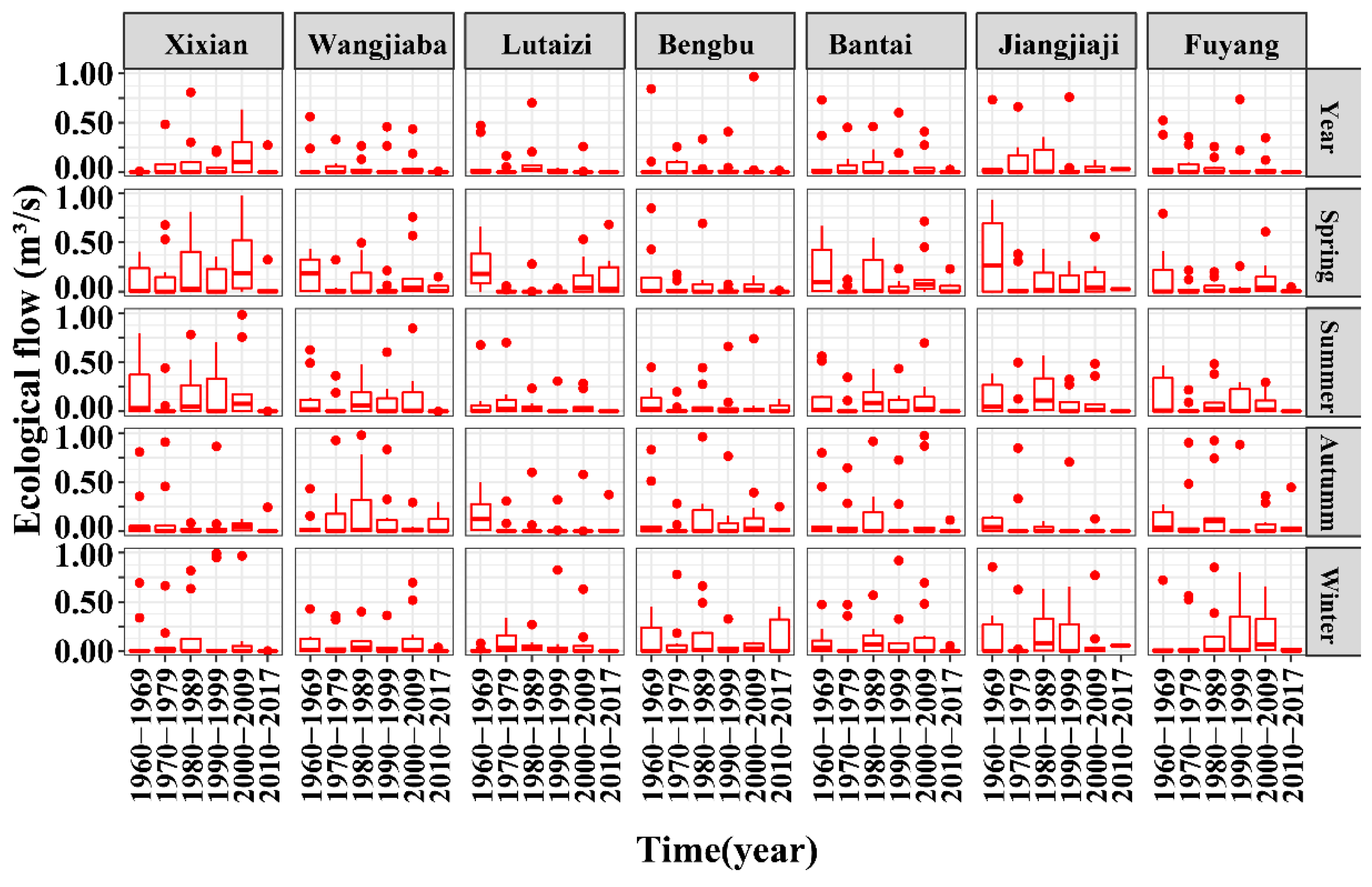
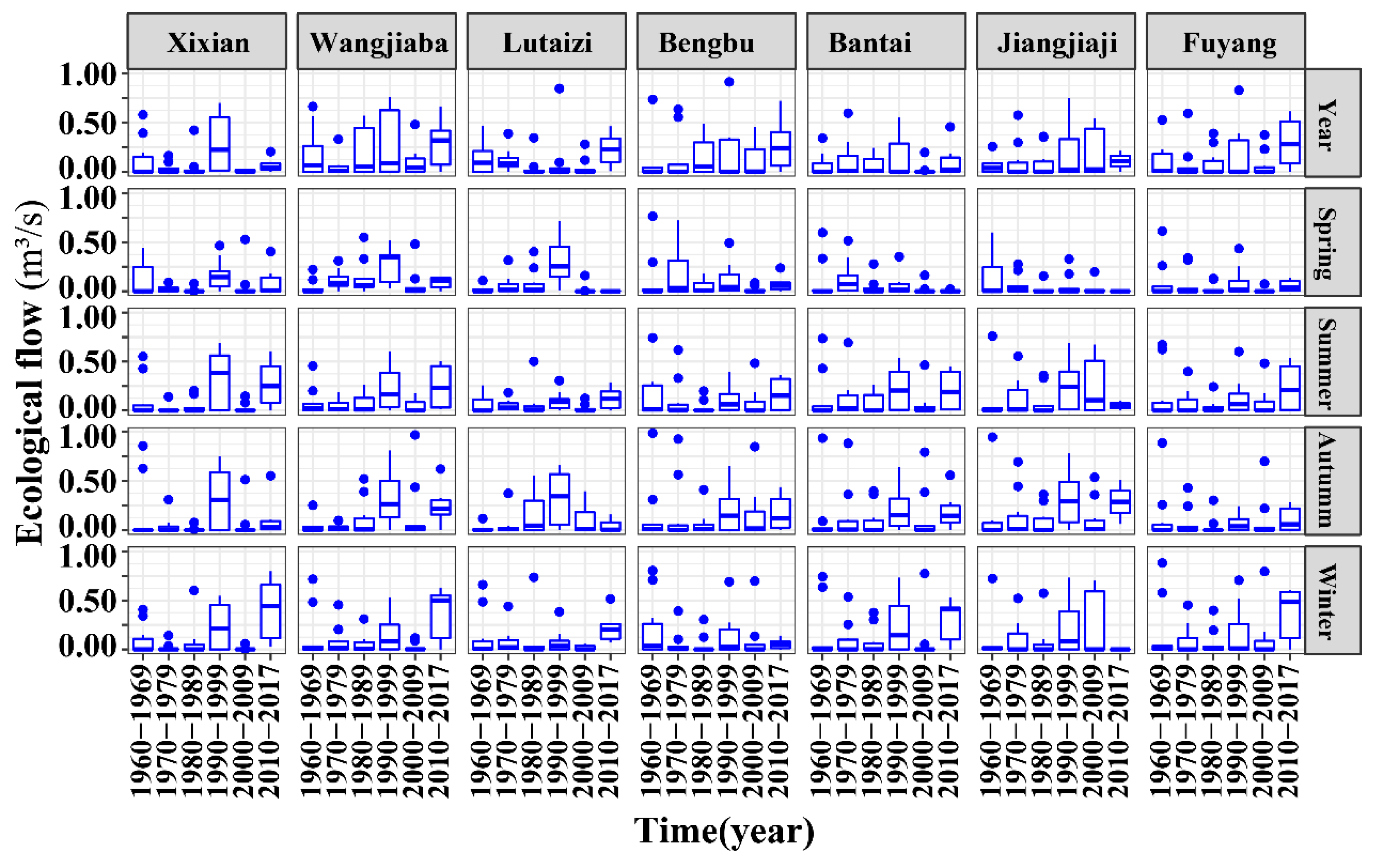
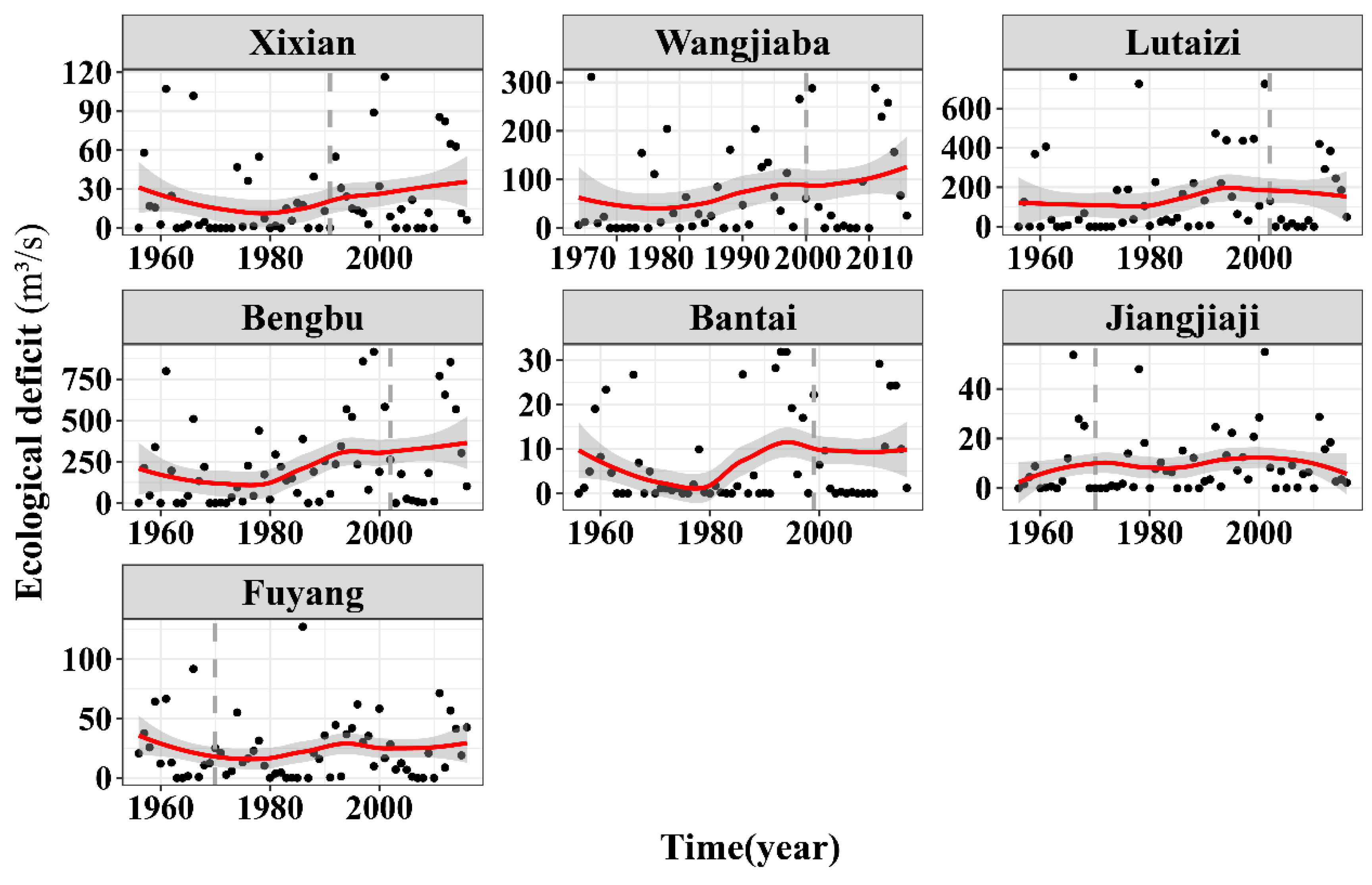
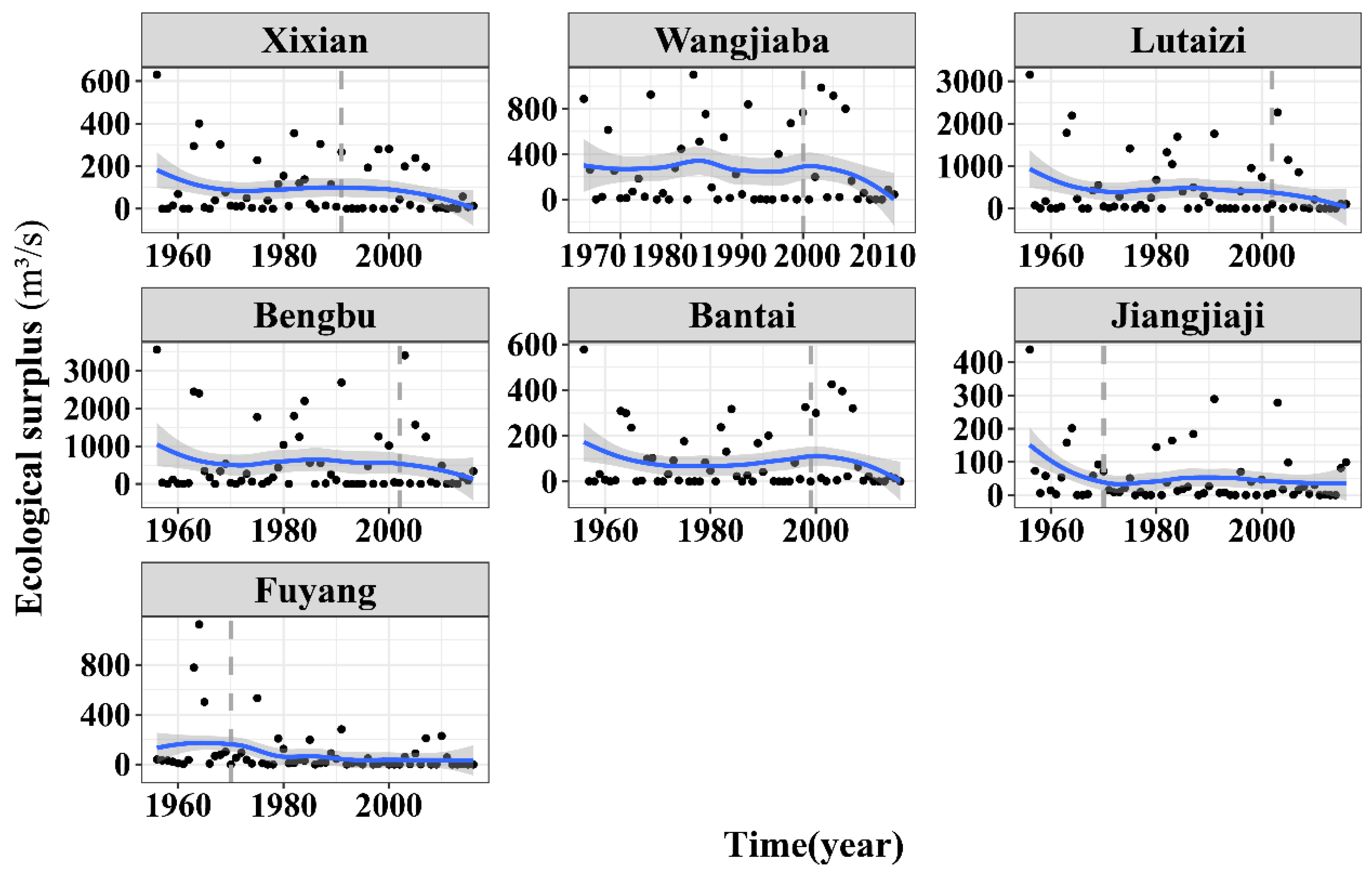
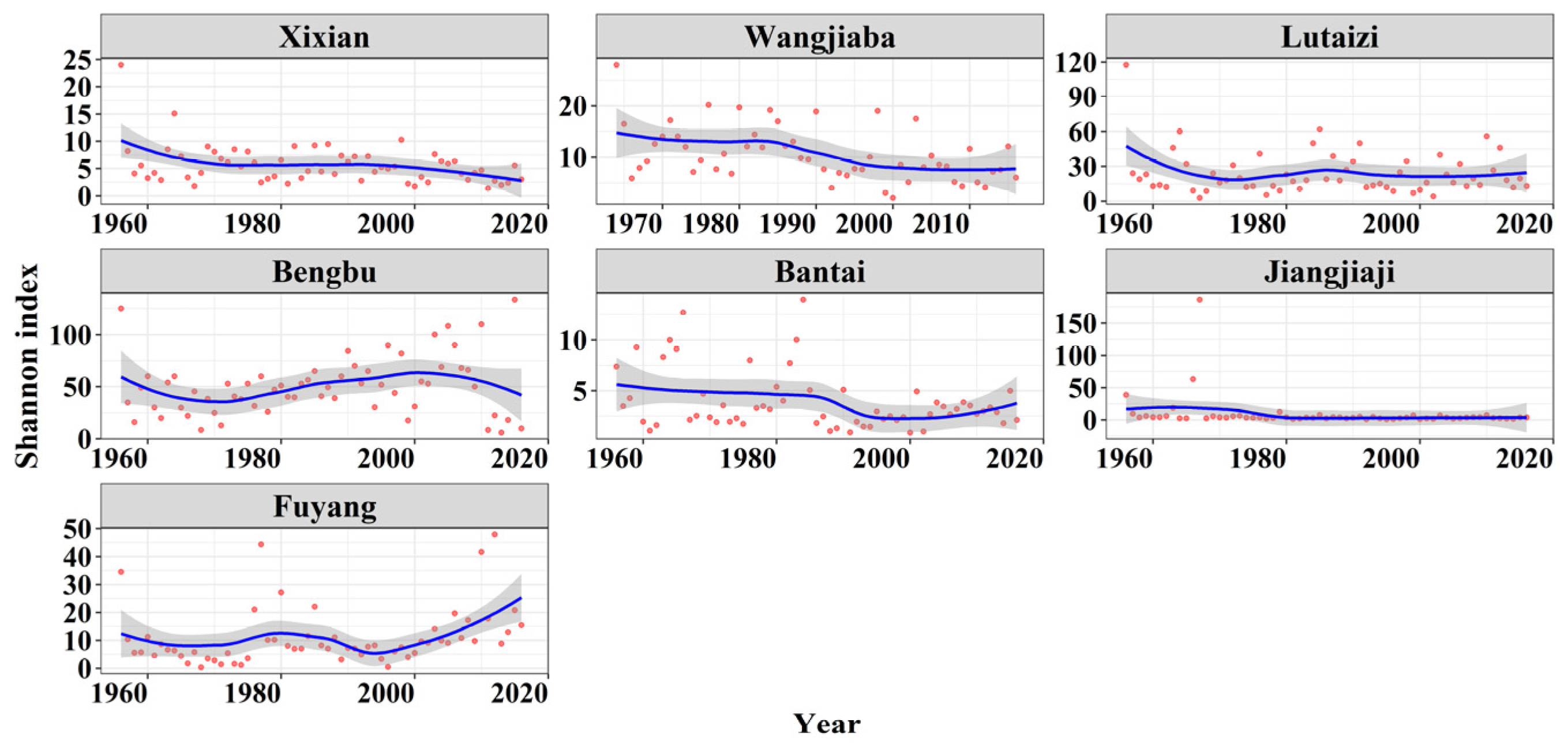

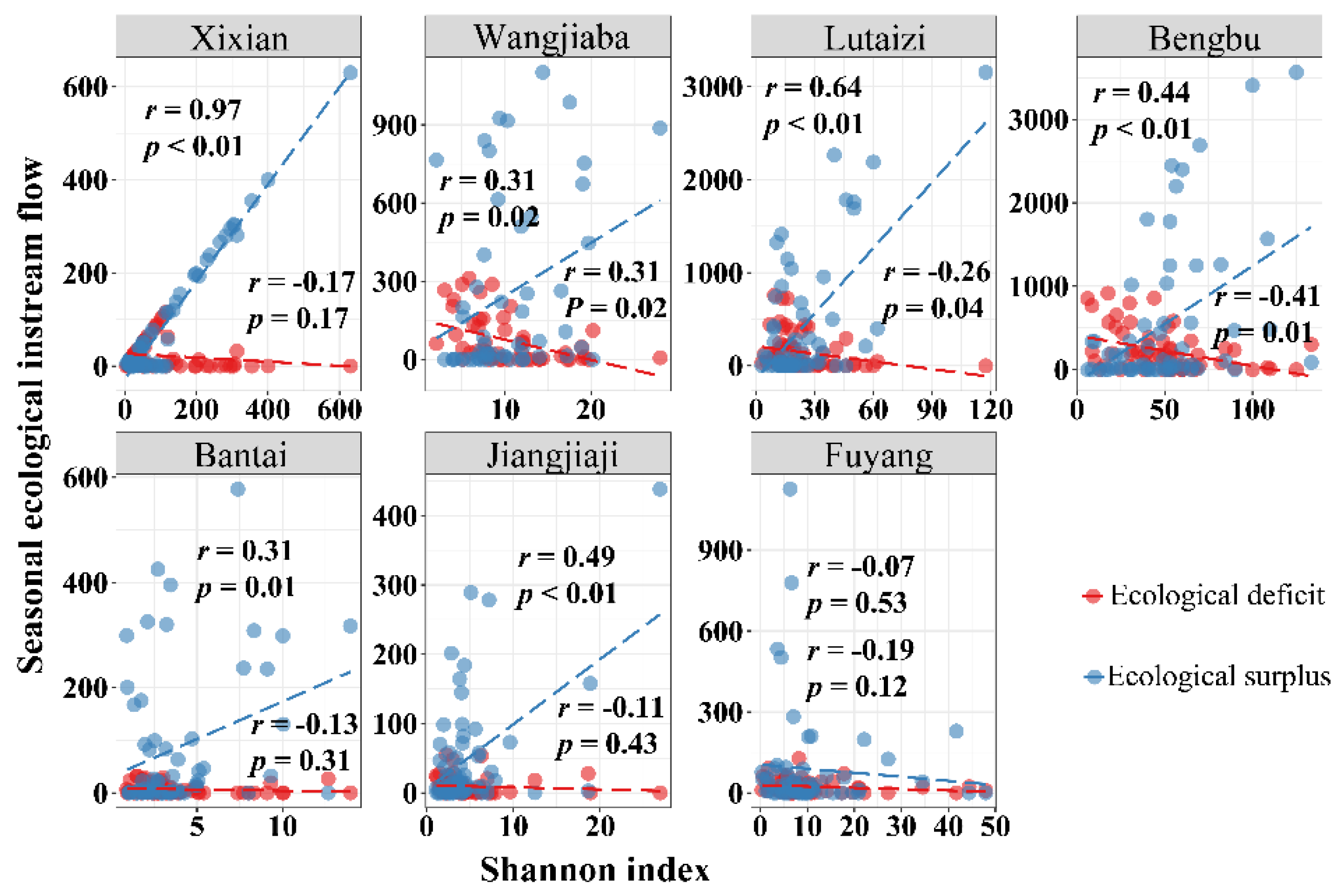
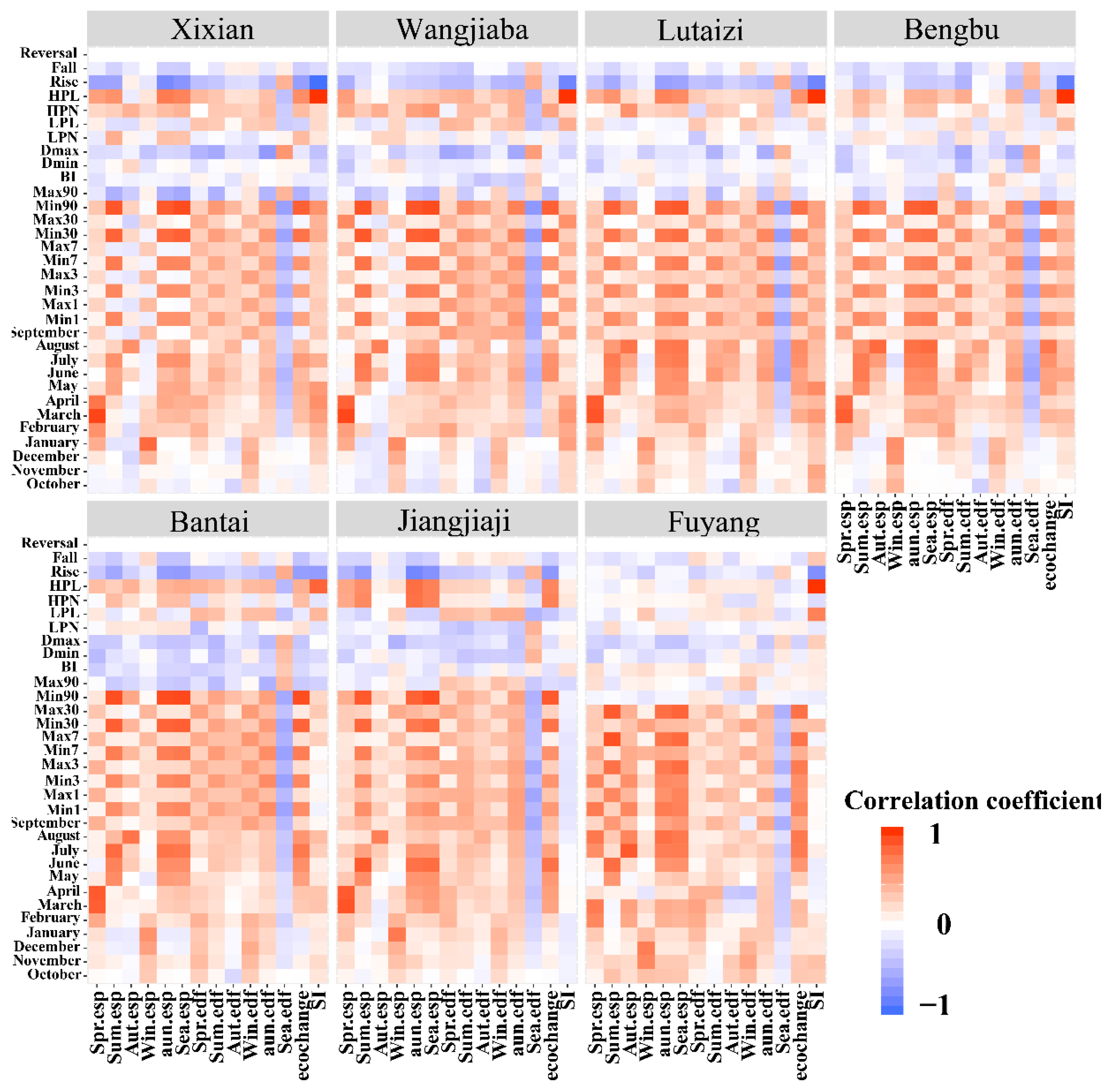
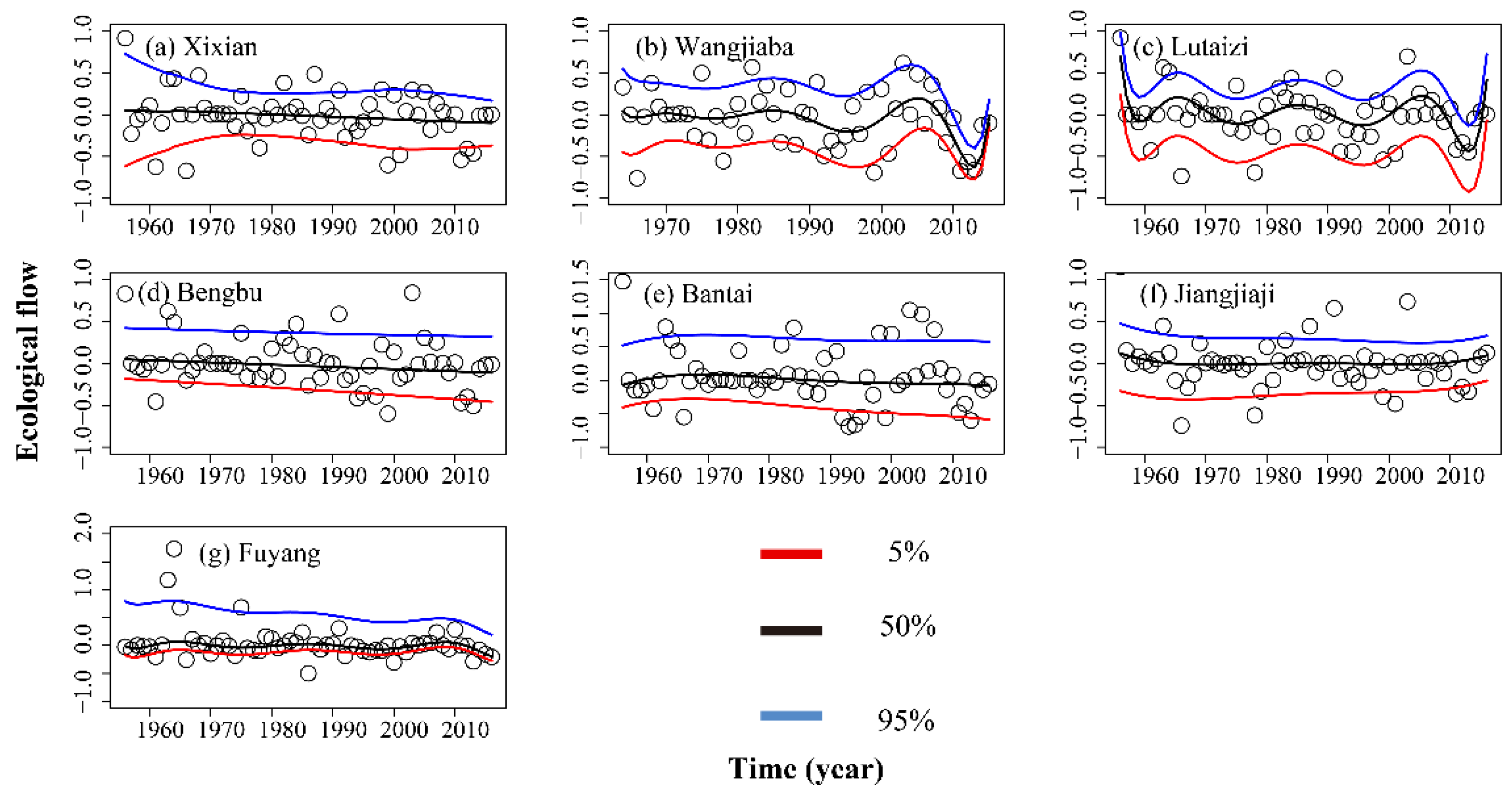
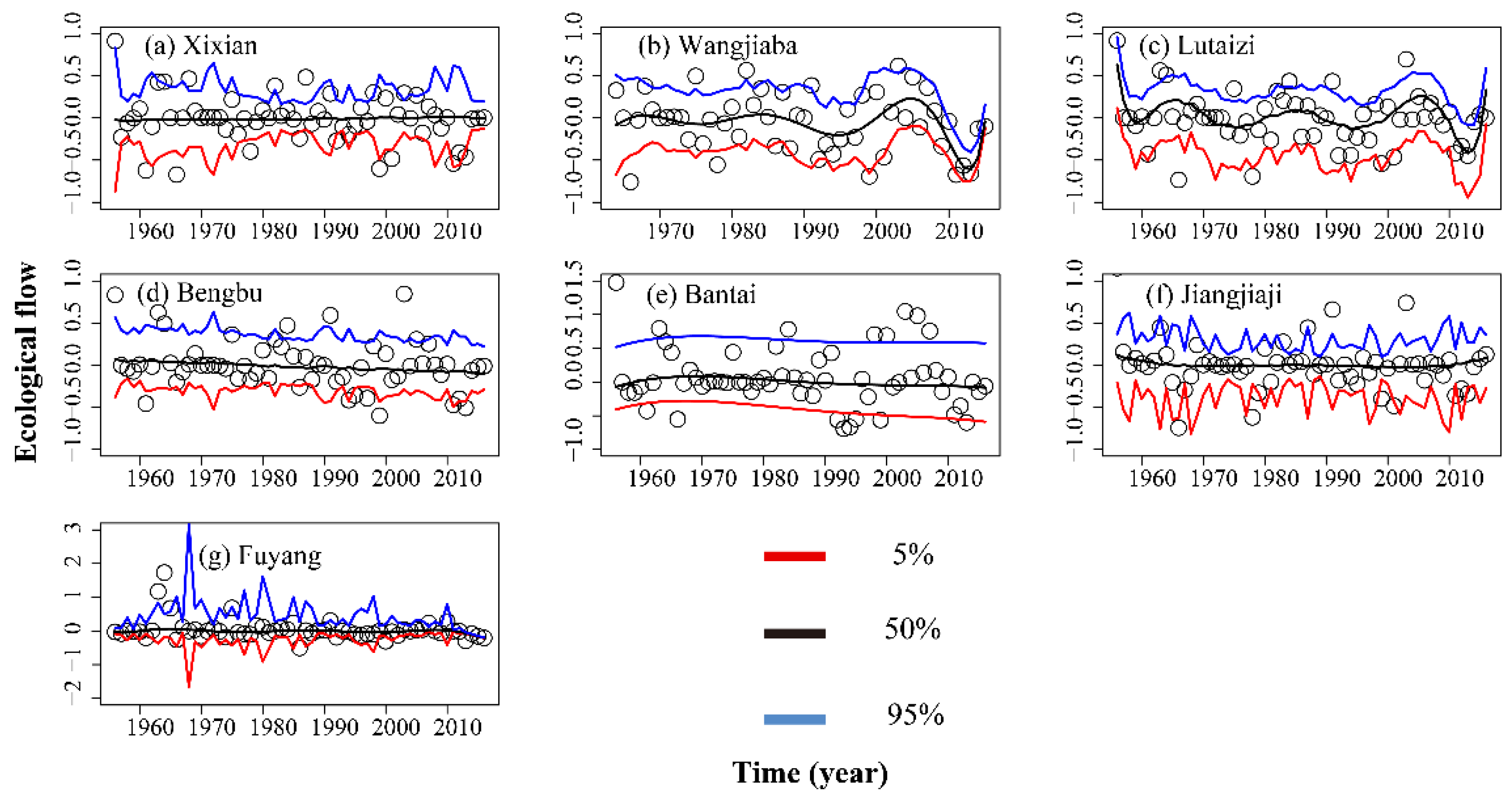
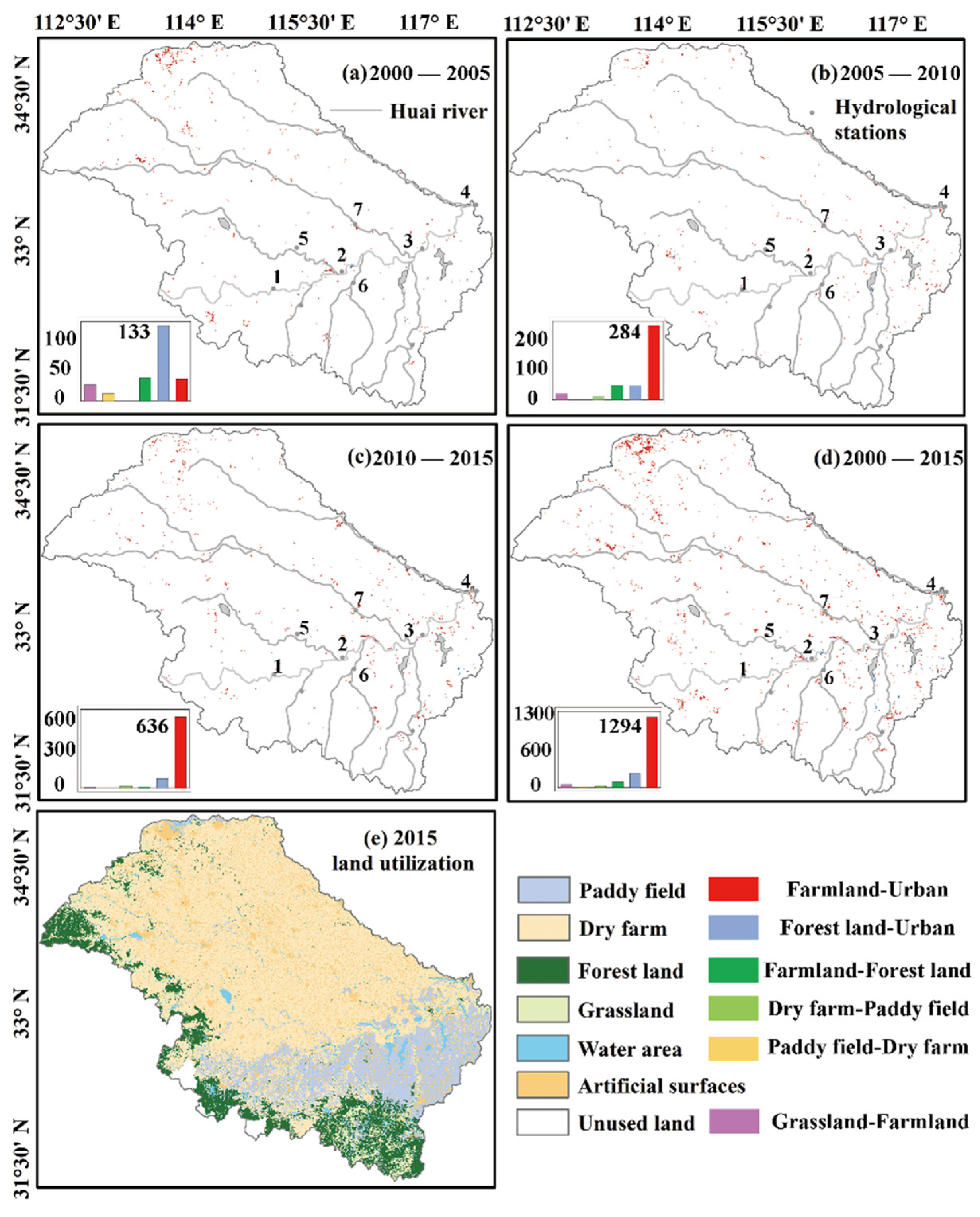
| River | Hydrological Station | Basin Area/km2 | Length of River/km | Slope of River Bed/% | Annual Runoff/108 m3 | Mean Annual Runoff Depth/mm | |
|---|---|---|---|---|---|---|---|
| Main river | Upstream | Xixian | 10,190 | 250 | 4.9 | 62.2 | 60.8 |
| Midstream | Wangjiaba | 30,630 | 364 | 0.35 | 99.8 | 32.5 | |
| Midstream | Lutaizi | 88,630 | 529 | 0.3 | 250 | 28.2 | |
| Midstream | Bengbu | 121,330 | 651 | 0.3 | 299 | 24.6 | |
| Branch | Hong Ru River | Bantai | 11,663 | 240 | 1 | 28.1 | 24.0 |
| Shi Guan River | Jiangjiaji | 5930 | 172 | 9.2 | 31.5 | 53.1 | |
| Sha Ying River | Fuyang | 35,250 | 490 | 0.03 | 55.6 | 15.7 | |
| IHA Parameter Group | Hydrological Parameters | Ecosystem Influences |
|---|---|---|
| Group 1: Magnitude of monthly water conditions | Meadin value for each calendar month | Habitat availability for aquatic organisms Soil moisture availability for plants Availability of water for terrestrial animals |
| Group 2: Magnitude and duration of annual extreme water conditions | Annual minima 1-day means Annual maxima 1-day means Annual minima 3-day means Annual maxima 3-day means Annual minima 7-day means Annual maxima 7-day means Annual minima 30-day means Annual maxima 30-day means Annual minima 90-day means Annual maxima 90-day means Base flow index: 7-day minimum flow/mean flow for year | Balance of competitive, ruderal and stress tolerant organisms Creation of sites for plant colonization Structuring of aquatic ecosystems by abiotic vs. biotic factors Structuring of river channel morphology and physical habitat conditions |
| Group 3: Timing of annual extreme water conditions | Julian date of each annual 1 day maximum Julian date of each annual 1 day minimum | Compatibility with life cycles of organisms Predictability/avoidability of stress for organisms Access to special habitats during reproduction or to avoid predation |
| Group 4: Frequency and duration of high and low pulses | Number of high pulse esch year Number of low pulse each year Mean duration of high pulses within each year Mean duration of low pulses within each year | Frequency and magnitude of soil moisture stress for plants Frequency and magnitude of soil moisture stress for plants Frequency and duration of anaerobic stress for plants Availability of floodplain habitats for aquatic organisms Nutrient and organic matter exchanges between river and floodplain |
| Group 5: Rate and frequency of water condition changes | Rise rates: mean of all positive differences between consecutive daily values Fall rates: mean of all negative differences magnitude between consecutive daily values Number of hydrologic reversals | Drought stress on plants Entrapment of organisms on islands, floodplains Desiccation stress on low-mobility stream edge (varial zone) organisms |
| Hydrologicalstation | Xixian | Wangjiaba | Lutaizi | Bengbu | Bantai | Jiangjiaji | Fuyang | Mean of AIC |
|---|---|---|---|---|---|---|---|---|
| Model | PE | exGAUS | exGAUS | exGAUS | NOF | TF | TF | |
| Model 1 (Stationary) | 24.0 | 44.4 | 36.3 | 19.2 | 51.0 | 21.6 | 25.2 | 31.7 |
| Model 2 (μ = PDO) | 25.7 | 46.0 | 38.2 | 19.3 | 53.0 | 19.5 | 25.2 | 32.4 |
| Model 3 (σ = NAO) | 24.9 | 44.1 | 38.2 | 20.2 | 52.8 | 23.5 | 25.0 | 32.7 |
| Model 4 (v = Nino3.4) | 25.8 | 45.4 | 39.0 | 17.9 | 52.9 | 20.3 | 24.0 | 32.2 |
| Model 5 (μ = PDO, σ = NAO) | 28.2 | 46.8 | 37.0 | 17.7 | 54.3 | 20.9 | 24.7 | 32.8 |
| Model 6 (μ = PDO, v = Nino3.4) | 23.5 | 47.0 | 37.2 | 17.1 | 54.0 | 22.0 | 23.9 | 32.1 |
| Model 7 (σ = NAO, v = Nino3.4) | 22.5 | 48.9 | 37.3 | 18.7 | 54.3 | 22.3 | 24.4 | 32.6 |
| Model 8 (μ = PDO, σ = NAO, v = Nino3.4) | 23.1 | 44.0 | 35.3 | 17.0 | 52.3 | 19.6 | 24.7 | 30.9 |
| Difference between the optimal and Model1 | 1.6 | 0.4 | 1.0 | 2.2 | 0.0 | 2.1 | 1.3 |
Publisher’s Note: MDPI stays neutral with regard to jurisdictional claims in published maps and institutional affiliations. |
© 2021 by the authors. Licensee MDPI, Basel, Switzerland. This article is an open access article distributed under the terms and conditions of the Creative Commons Attribution (CC BY) license (http://creativecommons.org/licenses/by/4.0/).
Share and Cite
Wen, Q.; Sun, P.; Zhang, Q.; Li, H. Nonstationary Ecological Instream Flow and Relevant Causes in the Huai River Basin, China. Water 2021, 13, 484. https://doi.org/10.3390/w13040484
Wen Q, Sun P, Zhang Q, Li H. Nonstationary Ecological Instream Flow and Relevant Causes in the Huai River Basin, China. Water. 2021; 13(4):484. https://doi.org/10.3390/w13040484
Chicago/Turabian StyleWen, Qingzhi, Peng Sun, Qiang Zhang, and Hu Li. 2021. "Nonstationary Ecological Instream Flow and Relevant Causes in the Huai River Basin, China" Water 13, no. 4: 484. https://doi.org/10.3390/w13040484






